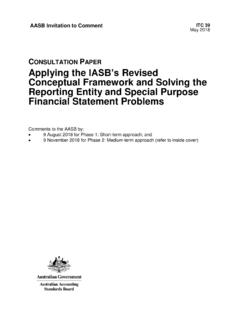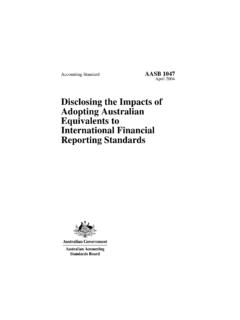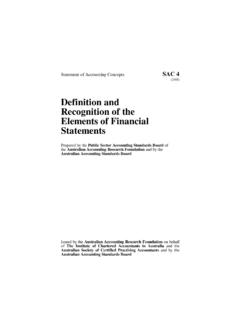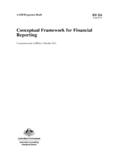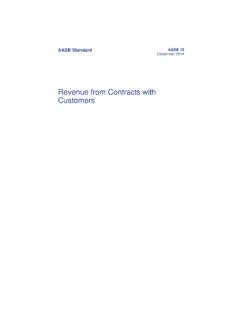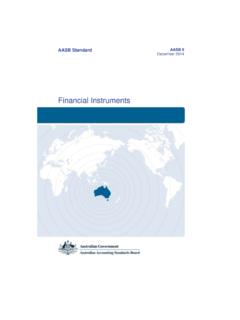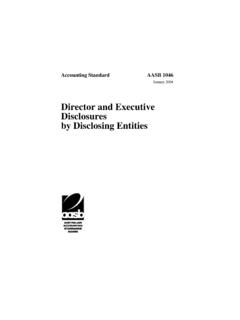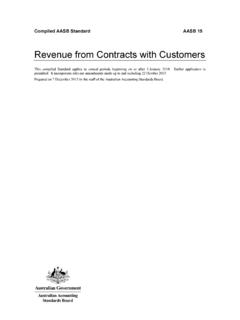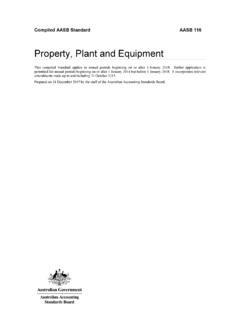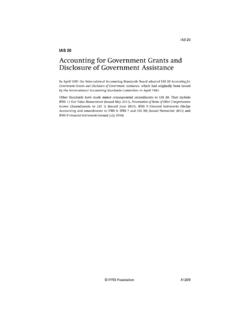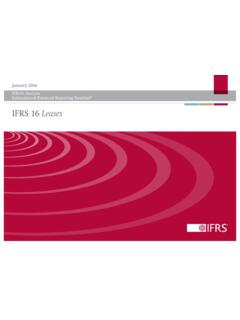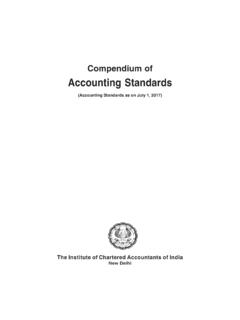Transcription of Accounting for Goodwill - Australian Accounting Standards ...
1 Australian Accounting StandardAAS 18 June 1996 Accounting for GoodwillPrepared by thePublic Sector Accounting Standards Board of theAustralian Accounting Research Foundation and by theAustralian Accounting Standards BoardIssued by theAustralian Accounting Research Foundationon behalf of the Australian Society of CertifiedPractising Accountants and The Institute ofChartered Accountants in AustraliaAAS 182 Obtaining a Copy of this Accounting StandardCopies of this Standard are available for purchase from the AustralianAccounting Research Foundation by contacting:The Customer Service OfficerAustralian Accounting Research Foundation211 Hawthorn RoadCaulfield Victoria 3162 AUSTRALIAP hone:(03) 9523 8111 Fax:(03) 9523 1996 Australian Accounting Research Foundation. The copying of thisStandard is only permitted in certain circumstances. Enquiries should bedirected to the Australian Accounting Research 1034-3717 AAS 183 CONTENTSMAIN FEATURES OF THE STANDARD.
2 Page 5 Section and page number1 Application .. 62 Operative Date .. 63 Purpose of Standard .. 74 Internally Generated Goodwill .. 75 Purchased Goodwill .. 8 Accounting Treatment for PurchasedGoodwill .. 8 Measurement of Purchased Goodwill .. 116 Subsequent Changes in Cost ofAcquisition .. 127 Subsequent Identification of Assets andLiabilities .. 138 Discount on Acquisition .. 139 Treatment on Consolidation ofGoodwill/Discount on Acquisition .. 1510 Acquisition of an Associated Company .. 1511 Disclosures .. 1512 Comparative Information .. 1613 Transitional Provisions .. 16 Application of the Straight-Line Method .. 16 Superseded Standard Applied to Entity .. 17 Superseded Standard Did Not Apply toEntity .. 17 AAS 18414 Definitions .. 18 CONFORMITY WITH INTERNATIONAL AND NEWZEALAND Accounting Standards .. page 20 Defined words appear in italics the first time they appear in asection. The definitions are in Section 14.
3 Standards are printedin bold type and commentary in light 185 MAIN FEATURES OF THE STANDARDThe Standard prescribes the Accounting treatment for Goodwill and discounton acquisition arising on acquisition of a business entity, or part thereof,through acquisition of the assets, or in the case of an investment in asubsidiary or in an associated company, through the acquisition of some orall of the shares in another entity. The Standard also prescribes theaccounting treatment for internally generated main revision to the superseded Australian Accounting Standard AAS18 " Accounting for Goodwill " is that the straight-line method ofamortisation has been Standard has been presented in plain English format, consistent withthe approach adopted in recent Standards and exposure drafts issued by theBoards. However, aside from amendments to effect the revision outlinedabove, the requirements of the Standard remain the same as those of thesuperseded 186 Accounting STANDARDAAS 18 " Accounting FOR Goodwill " Standard applies to general purpose financial reports of:(a)each private sector reporting entity; and(b)each public sector reporting entity;to which Accounting Standards operative under theCorporations Law do not Standard applies to financial reports that are held out tobe general purpose financial reports by an entity which is not areporting entity and to which Accounting Standards operativeunder the Corporations Law do not Standards operative under the Corporations Law applyto companies and to other entities required by legislation,ministerial directive or other government authority to apply suchStandards.
4 Reporting entities which are not required to applyAccounting Standards operative under the Corporations Law arerequired to apply this Standards specified in this Standard apply to the financialreport where information resulting from their application ismaterial, in accordance with Australian Accounting Standard AAS5 "Materiality".2 Operative Standard applies to reporting periods ending on or after 30 June Standard may be applied to reporting periods endingbefore 30 June 187 18 " Accounting for Goodwill ", as issued in March 1984,continues to apply for reporting periods that end before 30 June1996. However, where an entity elects to apply this Standard earlyin accordance with paragraph it will not also be obliged tocomply with AAS 18, as issued in March 1984, for the reportingperiods to which the election operative, this Standard supersedes AustralianAccounting Standard AAS 18 as issued in March of purpose of this Standard is to:(a)specify the manner of Accounting for Goodwill anddiscount on acquisition on the acquisition of an entity, orpart thereof; and(b)require disclosure of information relating to Goodwill sothat users of general purpose financial reports areprovided with information about the financial positionand performance of the reporting Generated which is internally generated by the entity must not berecognised by that which is internally generated by an entity is not permittedby this Standard to be recognised as an asset by that entity.
5 This isprincipally because of the difficulty, or impossibility, of identifyingthe events or transactions which contribute to the overall goodwillof the entity. Even if these were identifiable, the extent to whichthey generate future benefits and the value of such benefits wouldnot usually be capable of being measured reliably. If internallygenerated Goodwill is not recognised as an asset, it will either gocompletely unrecognised or will be recognised as an 188 GoodwillAccounting Treatment for Purchased which is purchased by the entity must be recognised asa non-current asset at acquisition, except in the case of aninvestment in an associated Goodwill is purchased in a business acquisition the exchangetransaction enables the value of Goodwill to be measured number of methods of Accounting for such purchased goodwillexists. Principally these methods include either recognising theexpenditure as:(a)an asset.
6 Or(b)an expense at the time when the acquisition is view adopted in this Standard is that purchased goodwillrepresents future benefits acquired in an exchange transactionwhich need to be recognised as an alternative Accounting treatment, whereby purchased goodwillis recognised as an expense at the time of acquisition, is notsupported because it fails to recognise the future benefits (includingsynergistic benefits) arising from the unidentifiable assets alternative Accounting treatment for purchased Goodwill isto write-off Goodwill against reserves at the time of treatment is unacceptable since it too fails to recognise thefuture benefits acquired, contravenes the requirements of AustralianAccounting Standard AAS 1 "Profit and Loss or Other OperatingStatements" and is contrary to the spirit of Australian AccountingStandard AAS 4 "Depreciation of Non-Current Assets". this Standard the view adopted is that Goodwill comprises thefuture benefits from unidentifiable assets which, because of theirnature, are not normally individually recognised.
7 Unidentifiableassets would usually include market penetration, effectiveadvertising, good labour relations and a superior operating 189 would exclude assets of an intangible nature which are capableof being both individually identified and specifically recorded, asmay be the case with patents, licences, rights and distinction is frequently drawn between Goodwill which ispurchased and Goodwill which is internally generated. The viewtaken in this Standard is that the concept of Goodwill is the sameregardless of whether it has been purchased in an exchangetransaction or generated internally. The only distinction is thatpurchased Goodwill can be measured reliably on the basis of theamount paid for it, while internally generated Goodwill is notusually capable of being measured reliably. Consequently, theaccounting treatment specified in this Standard for purchasedgoodwill differs from that specified for internally is normally only recognised by a purchaser in connectionwith the acquisition of a business entity, or part thereof, throughacquisition of the assets therein or, in the case of an investment in asubsidiary or in an associated company, the acquisition of some orall of the shares in another entity.
8 Such purchased Goodwill reflectsfuture benefits from two sources: those which have been internallygenerated by the vendor prior to the date of acquisition and whichare expected to flow to the purchaser, and those which arise fromthe combination or inter-relationship of entities or groups of assets(synergistic benefits). Goodwill must be amortised so that it is recognised asan expense in the profit and loss or other operating statement ona straight-line basis, over the period from the date of acquisitionto the end of the period of time during which the benefits areexpected to arise. This period must not exceed twenty yearsfrom the date of accordance with paragraph , the unamortised balance ofgoodwill must be reviewed as at each reporting date and recognisedas an expense to the extent that it is no longer supported byprobable future 1810 order to amortise Goodwill over the period during which theassociated benefits are expected to arise, separate assessments mayneed to be made in respect of different Goodwill components (suchas those relating to the purchase of different businesses) to theextent that such components can be separately which ought to be considered in estimating the useful livesof the assets comprising Goodwill include:(a)effects of obsolescence, demand and other economicfactors; and(b)the service life expectancies of individual employees orgroups of employees; and(c)expected actions by competitors or potential competitors.
9 And(d)relevant legal, regulatory or contractual provisions; and(e)foreseeable life of the entity or the period of anticipated benefits will in manycircumstances be difficult to identify, decisions concerning theperiod of amortisation may be arbitrary. For this reason, in nocircumstance does this Standard permit the amortisation period toexceed twenty years. However, it is anticipated that in manycircumstances the period will be considerably shorter than twentyyears from the date of to paragraph , the period over which Goodwill is tobe amortised must be reviewed as at each reporting date and, ifnecessary, adjusted to reflect the amount and timing of expectedfuture benefits. The period must not extend beyond twentyyears from the date of period over which Goodwill is to be amortised needs to bereviewed as at each reporting date and, if necessary, adjustmentsmade in a manner consistent with the provisions of AustralianAccounting Standard AAS 4 "Depreciation of Non-Current Assets".
10 AAS 1811 of Purchased acquisition of some, or all, of the assets of another entity, orin the case of an investment in a subsidiary or associatedcompany, on acquisition of some, or all, of the shares of anotherentity, the identifiable net assets acquired must be measured attheir fair value is a measure of the worth of an asset at a specified time,and is utilised in this Standard as the amount which the purchaserattributes to the assets acquired. When making an assessment ofthe fair values to be attributed to individual assets, the purchasermay sometimes find that a number of such assets are combined intoa related or composite group (such as the units of plant in a steelmill). In these circumstances, it may be more appropriate toconsider the fair value of the composite group rather than theaggregate of the fair values of the individual Goodwill must be measured as the excess of thepurchase consideration plus incidental expenses over the fairvalue of the identifiable net assets purchase consideration may take the form of any one, orcombination, of the following:(a)cash; and/or(b)other monetary assets; and/or(c)non-monetary assets; and/or(d)securities issued.
